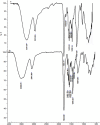The Anti-candidal and Absorbtion Performance of PVA/PVP-Based Jania rubens Hydrogel on Candida tropicalis and Some Physicochemical Properties of the Hydrogel
- PMID: 38963589
- PMCID: PMC11695445
- DOI: 10.1007/s12010-024-04997-1
The Anti-candidal and Absorbtion Performance of PVA/PVP-Based Jania rubens Hydrogel on Candida tropicalis and Some Physicochemical Properties of the Hydrogel
Abstract
This study was aimed to create a bioactive hydrogel form with PVA/PVP (polyvinyl alcohol/poly(N-vinylpyrrolidone) polymer using acetone and ethanol extractions of Jania rubens red algae and investigate some pharmaceutical properties. The anti-candidal activity and some inhibition performance of J. rubens/PVA/PVP hydrogel were investigated on Candida tropicalis which is one of the important causes of bloodstream infections. The physicochemical properties of J. rubens/PVA/PVP hydrogel were revealed using FTIR and swelling-absorption tests. The volatile compounds of J. rubens extracts were examined by GCMS. By mixing the extracts in equal proportions, PVA/PVP-based hydrogel was prepared. According to the results, Cumulative Drug Release was stable at 25 °C for the first 5 h. The IZ (inhibition zone) and MIC (minimum inhibitory concentration) of J. rubens/PVA/PVP hydrogel were 9.01 mm and 80.20 mg/mL, respectively. It was found that logarithmic reduction and percent reduction were seen as 1.5 CFU/mL and 97.5%, respectively, on C. tropicalis exposed to J. rubens/PVA/PVP hydrogel in the first 5 min of the incubation. After exposure of C. tropicalis to J. rubens/PVA/PVP, the number of viable cells transferred from the gel to water was between 76.1 and 73.1% in high glucose medium, while it was between 92.2 and 80.8% for the PVA/PVP hydrogel under the same conditions. As a result, PVA/PVP hydrogel was made bioactive with J. rubens extracts for the first time in this study, and its potential for use as a functional anticandidal hydrogel on C. tropicalis has been demonstrated.
Keywords: Candida tropicalis; Jania rubens; Anti-candidal activity; Hydrogel.
© 2024. The Author(s).
Conflict of interest statement
Declarations. Ethical Approval: Not applicable. Competing Interests: The authors declare no competing interests.
Figures





Similar articles
-
Design of hybrid PVA-CA-Jania rubens biomatrix for removal of lead.Int J Phytoremediation. 2017 Feb;19(2):183-190. doi: 10.1080/15226514.2016.1207603. Int J Phytoremediation. 2017. PMID: 27416331
-
Tribological properties of PVA/PVP blend hydrogels against articular cartilage.J Mech Behav Biomed Mater. 2018 Feb;78:36-45. doi: 10.1016/j.jmbbm.2017.10.027. Epub 2017 Oct 25. J Mech Behav Biomed Mater. 2018. PMID: 29132099
-
Novel Synergistic Approach: Tazarotene-Calcipotriol-Loaded-PVA/PVP-Nanofibers Incorporated in Hydrogel Film for Management and Treatment of Psoriasis.Mol Pharm. 2023 Feb 6;20(2):997-1014. doi: 10.1021/acs.molpharmaceut.2c00713. Epub 2023 Jan 11. Mol Pharm. 2023. PMID: 36630478
-
Biomaterials of PVA and PVP in medical and pharmaceutical applications: Perspectives and challenges.Biotechnol Adv. 2019 Jan-Feb;37(1):109-131. doi: 10.1016/j.biotechadv.2018.11.008. Epub 2018 Nov 22. Biotechnol Adv. 2019. PMID: 30472307 Review.
-
Water-soluble polymeric xenobiotics - Polyvinyl alcohol and polyvinylpyrrolidon - And potential solutions to environmental issues: A brief review.J Environ Manage. 2018 Dec 15;228:213-222. doi: 10.1016/j.jenvman.2018.09.010. Epub 2018 Sep 15. J Environ Manage. 2018. PMID: 30223180 Review.
Cited by
-
Impact of Ultrasound- and Microwave-Assisted Extraction on Bioactive Compounds and Biological Activities of Jania rubens and Sargassum muticum.Mar Drugs. 2024 Nov 25;22(12):530. doi: 10.3390/md22120530. Mar Drugs. 2024. PMID: 39728105 Free PMC article.
References
-
- Karabay-Yavasoglu, N. U., Sukatar, A., Ozdemir, G., et al. (2007). Antimicrobial activity of volatile components and various extracts of the red alga Janiarubens. Phytotherapy Research,21, 153–156. 10.1002/ptr.2045 - PubMed
-
- Awad, N. E. (2004). Bioactive brominated diterpenes from the marine red alga Janiarubens (L.) Lamx. Phytotherapy Research,18, 275–279. 10.1002/ptr.1273 - PubMed
-
- El-Din, S. M. M., & El-Ahwany, A. M. (2016). Bioactivity and phytochemical constituents of marine red seaweeds (Janiarubens, Corallinamediterranea, and Pterocladiacapillacea). Journal Taibah University for Science,10, 471–484. 10.1016/j.jtusci.2015.06.004
-
- Aydin, B. (2022). Antioxidant properties of some macroalgae harvested from the Iskenderun Bay Turkey. Fresenius Environ Bulletin and Advances in Food Sciences,31, 2145–2152.
-
- Ismail-Ben Ali, A., El Bour, M., Ktari, L., Bolhuis, H., Ahmed, M., Boudabbous, A., & Stal, L. J. (2012). Jania rubens-associated bacteria: Molecular identification and antimicrobial activity. Journal of applied phycology,24, 525–534.
MeSH terms
Substances
Grants and funding
LinkOut - more resources
Full Text Sources
Research Materials
Miscellaneous

